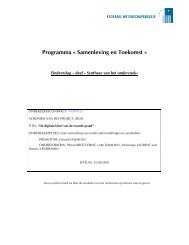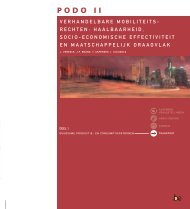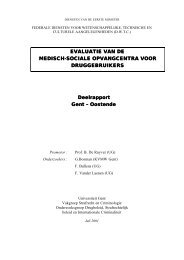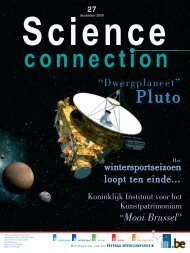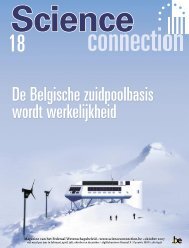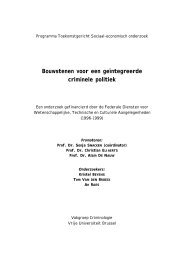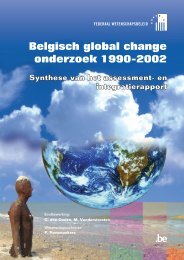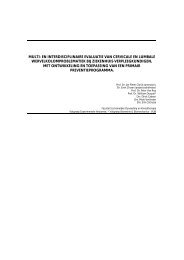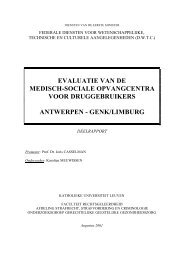chapter 3 inventory of local food systems
chapter 3 inventory of local food systems
chapter 3 inventory of local food systems
Create successful ePaper yourself
Turn your PDF publications into a flip-book with our unique Google optimized e-Paper software.
Project CP/59 - “Instruments and institutions to develop <strong>local</strong> <strong>food</strong> <strong>systems</strong>”<br />
• for the employer: possibly more flexible employees, who would be prepared to<br />
work temporarily more, or less, during peak respectively less busy periods, and<br />
who could possibly reach a helping hand at the last moment.<br />
In order to measure the impact on employment, the number <strong>of</strong> full-time equivalents<br />
employed by the various <strong>systems</strong>, related to the added value they create, can be<br />
compared.<br />
Real price <strong>of</strong> <strong>food</strong><br />
The real price <strong>of</strong> the <strong>food</strong> we buy implies a correct price for the farmer and deducts the<br />
above mentioned energy consumption and the environmental impacts that are caused<br />
by transport, packaging and waste treatment. The <strong>food</strong> we consume at present is<br />
artificially cheap because these aspects <strong>of</strong> the <strong>food</strong> supply chain are not being<br />
considered in the price.<br />
(www.mcspotlight.org/media/reports/<strong>food</strong>miles.html)<br />
A recharge <strong>of</strong> the real price <strong>of</strong> the products could be a possibility to solve, among other<br />
things, the problem <strong>of</strong> growing road transport. At present, many costs are being<br />
externalised. That means they are being transferred to public infrastructures and to the<br />
environment. The costs are paid by both the present and the future society. However, an<br />
adequate use <strong>of</strong> scarce production resources can only be achieved if we take into<br />
account the full costs, and if these are also all recharged in the price. As this is not<br />
occurring now, and the prices approach the real costs less and less, the environmental<br />
and social impacts increase and the inefficiency <strong>of</strong> the present system is <strong>of</strong>ten hushed up<br />
(Böge, 1995).<br />
1.3.2.2. Economic impact at consumer level<br />
For the consumer the value <strong>of</strong> an agricultural product (including landscape and<br />
environment) (s)he buys is unclear. The consumer buys packaging, processing, transport<br />
and publicity in products like meat, milk, cheese, vegetables,… A report <strong>of</strong> the ‘agrarian’<br />
value (the part that goes to the farmer on the countryside) <strong>of</strong> the product, apart from the<br />
‘industrial’ value (processing), ‘transport’ (logistics), ‘commercial’ value (promotion,<br />
publicity) and ‘fiscal’ value (VAT, taxes…) and the costs for control in the chain or the<br />
different links could <strong>of</strong>fer the producer and the consumer more insight in the life cycle<br />
and the price setting <strong>of</strong> <strong>food</strong>.<br />
1.3.2.3. Economic impact at producer level<br />
Depending on the kind <strong>of</strong> LFS (direct sales, network sale with contact, network sale with<br />
information, anonymous sale), the producer is more or less intensely concerned in the<br />
sales <strong>of</strong> what (s)he produces. A more direct sale can imply extra costs as well as extra<br />
income. There are for instance investment costs for the producer, new sales <strong>systems</strong> (e.g.<br />
a market stall, and also the time investment <strong>of</strong> the persons who man the stall), or in<br />
distributing information in the case <strong>of</strong> network sales. On the other hand the producer<br />
can obtain a better share from the income the product generates, through direct sales.<br />
The growth <strong>of</strong> the added value for the producers is depending on the scale and the<br />
quality <strong>of</strong> the production, but also <strong>of</strong> the inventiveness and the pr<strong>of</strong>essionalism <strong>of</strong> the<br />
SPSD II - Part I - Sustainable production and consumption patterns - Agro-Food 19



